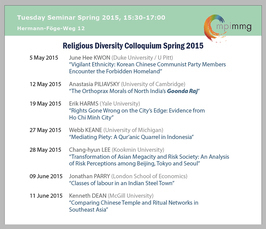"Classes of labour in an Indian Steel Town"
Religious Diversity Colloquium Spring 2015
- Datum: 09.06.2015
- Uhrzeit: 15:30 - 17:00
- Vortragender: Jonathan Parry (London School of Economics)
- Jonathan Parry is Emeritus Professor of Anthropology at the London School of Economics and Political Science. He has done field research in various parts of north and central India on various different topics. His publications include Caste and Kinship in Kangra (Routledge 1979), Death in Banaras (Cambridge University Press, 1994), Death and the Regeneration of Life (ed, with M. Bloch, Cambridge University Press, 1982), Money and the Morality of Exchange (ed, with M. Bloch, Cambridge University Press, 1989), The Worlds of Indian Industrial Labour (ed, with J. Breman and K. Kapadia, Sage Publications, 1999), Institutions and Inequalities (ed, with R. Guha, Oxford University Press, 1999), Questions of Anthropology (ed, with R. Astuti and C. Stafford, Berg, 2007), Industrial work and life: An anthropological Reader (ed, with G. De Neve and M. Mollona. London: Berg, 2009) and Persistence of Poverty in India (ed, with N. Gooptu, Social Science Press, 2014).
- Ort: MPI-MMG, Hermann-Föge-Weg 12, Göttingen
- Raum: Conference Room

For more details please contact vdvoffice(at)mmg.mpg.de.
The text to be circulated is the draft of the Introduction to a monograph on industrial labour in the central Indian steel town of Bhilai, and is intended to preview its central arguments. These have to do with processes of class differentiation within the manual labour force, and with the way in which class intersects with caste, regional ethnicity and gender. This workforce is deeply divided between those who have regular jobs in the organised sector on the one side, and the contract labour that works alongside them and workers in the informal sector on the other. These two fractions of labour represent distinct social classes with often competing interests, which are sometimes in conflict and between which there is even a relationship of exploitation. In most contexts, it is class that is the dominant axis of inequality in the town and the salience of caste is relatively attenuated, though this is varies between pubic and private sector workers and according to the type of neighbourhoods they inhabit. The class division between these different kinds of worker significantly overlaps with differences in regional ethnicity. Regular workers in the organised sector are overwhelmingly male, while women constitute a very significant proportion of workers in the informal sector, where their supposed sexual vulnerability provides powerful ideological justification for class inequalities. This sharp class differentiation within the ranks of manual labour that the book documents has to be understood in the light of more general processes of class ‘structuration’ – processes that are by no means particular to India and that may help us explain why the labour elite is sometimes set apart form the rest of ‘the working class’ and is sometimes its militant vanguard.